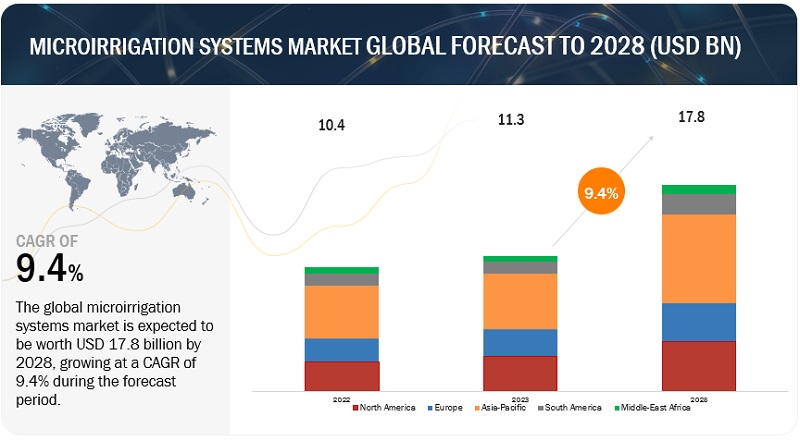Microirrigation Systems Market Insights 2023-2028: Key Drivers, Opportunities, and Forecasts
The global microirrigation systems market is projected to grow from USD 11.3 billion in 2023 to USD 17.8 billion by 2028, registering a robust CAGR of 9.4% during the forecast period. This growth is driven by the increasing demand for efficient water management in drought-prone regions, higher crop yields, and the cost-effectiveness of advanced irrigation systems.

Emerging economies are playing a key role in market expansion, supported by a growing population and the predominance of agriculture as a major occupation. In addition, global initiatives from both public and private sectors are further fueling the adoption of microirrigation technologies.
What is Microirrigation — and Why It Matters?
Microirrigation refers to irrigation techniques that deliver water directly to the root zone of plants—using systems such as drip, micro-sprinkler, or micro-spray—rather than flooding or broad-scale sprinkler irrigation. The objective is to maximize water-use efficiency, minimize wastage (evaporation or runoff), and ensure precise, controlled watering for crops.
This precision means more water per drop reaches the plant, soil moisture is more stable, and nutrient delivery (often combined with fertigation) becomes more predictable and efficient. Because of this, microirrigation is widely regarded as a cornerstone of sustainable and precision agriculture, especially important in water-scarce and climate-sensitive regions.
- Efficient Water Usage: Water scarcity is a pressing global issue, and agriculture accounts for nearly 70% of freshwater consumption worldwide. Microirrigation systems minimize water wastage by delivering water directly to the plant roots, reducing evaporation and runoff. This precision irrigation approach not only conserves water but also ensures that crops receive the optimal moisture levels needed for growth.
- Increased Crop Yields: Microirrigation enables uniform water distribution and nutrient delivery, resulting in healthier crops and improved yields. By providing water and fertilizers directly to the root zone, these systems reduce stress on plants and enhance growth efficiency. For high-value crops like fruits, vegetables, and horticultural products, microirrigation can significantly improve both yield quantity and quality.
- Cost-Effectiveness and Labor Savings: Traditional irrigation methods often require substantial labor and energy inputs. Microirrigation reduces these operational costs, as systems can be automated to deliver water at specific times and quantities. This automation not only saves labor but also reduces energy consumption, leading to long-term cost savings for farmers.
- Support from Government Policies: Governments in several countries are promoting water-efficient irrigation systems through subsidies, grants, and training programs. These initiatives encourage farmers to adopt microirrigation systems, especially in water-scarce regions, thereby driving market growth.
- Rising Awareness in Emerging Economies: Countries with growing populations and limited arable land, such as India, Brazil, and Mexico, are increasingly adopting microirrigation systems. Farmers are recognizing the dual benefits of higher productivity and water conservation, which align with sustainable agriculture practices and environmental regulations.
Download PDF Brochure: https://www.marketsandmarkets.com/pdfdownloadNew.asp?id=566
Technological Advancements
Smart microirrigation systems integrated with IoT, sensors, and data analytics allow real-time monitoring of soil moisture and crop water needs. These systems automatically adjust water delivery, ensuring precise irrigation, reducing wastage, and improving productivity. Integration with precision agriculture technologies further enhances decision-making and resource efficiency.
Efficient Water Usage in Drought Conditions
Advanced microirrigation systems enable farmers to protect agricultural fields against drought, maintaining production levels even in challenging climatic conditions. With precision irrigation scheduling, farmers can optimize water usage while ensuring high crop yields. The availability of a wide range of systems—from basic water monitoring tools to advanced soil moisture sensors—has made it possible for farmers of different scales to combat water scarcity effectively.
Drip irrigation systems, in particular, offer higher efficiency compared to sprinkler systems, making them highly suitable for tropical regions where droughts are frequent. This efficiency is a key factor driving the adoption of microirrigation solutions globally.
Meeting the Demand for Higher Yields on Limited Land
As urbanization reduces available cropland worldwide, farmers increasingly rely on microirrigation to achieve optimal crop yields from limited areas. By delivering water directly to plant roots, these systems enable precise water application, improving crop quality and productivity even when water supplies are limited. This targeted approach helps farmers maximize output and resource efficiency, further supporting market growth.
Request Sample Pages: https://www.marketsandmarkets.com/requestsampleNew.asp?id=566
North America Emerges as a Key Growth Market
North America is expected to be the second fastest-growing region for microirrigation systems between 2023 and 2028. The region has traditionally been a significant consumer of drip irrigation systems, driven by the environmental and economic importance of freshwater resources. Small-scale farmers in the United States are increasingly adopting microirrigation technologies, particularly in the Midwest, due to water allocation concerns and a focus on sustainable agricultural practices.
Eminent players operating in the microirrigation systems market are Jain Irrigation Systems Ltd. (India), The Toro Company (US), Netafim (Israel), Nelson Irrigation (US), Rain Bird Corporation (US), Finolex Plasson (India), Mahindra EPC Irrigation Limited (India), T-L Irrigation (US), Hunter Industries (US), Rivulis (Israel), Chinadrip Irrigation Equipment co., Ltd. (China), Elgo Irrigation Ltd. (Israel), Antelco (Australia), Microjet (South Africa), and Irritec S.p.A (Italy), among others.
Future Outlook
The microirrigation systems market is expected to continue growing as the need for sustainable agriculture, efficient water use, and higher crop yields intensifies. Technological innovations, government support, and increasing farmer awareness will drive market expansion, making microirrigation a standard practice in agriculture worldwide.
Frequently Asked Questions (FAQs) – Microirrigation Systems Market
- Q1. What are microirrigation systems?
- Q2. What is the current market size of microirrigation systems?
- Q3. Which factors are driving the growth of the microirrigation systems market?
- Q4. What are the key benefits of microirrigation systems?
- Q5. Which regions are witnessing the highest adoption of microirrigation systems?
- Q6. What are the key challenges faced by the microirrigation market?
- Q7. Who are the leading players in the microirrigation systems market?
- Q8. How is technology influencing the microirrigation systems market?
- Q9. What is the future outlook for the microirrigation systems market?
About MarketsandMarkets™
MarketsandMarkets™ has been recognized as one of America’s Best Management Consulting Firms by Forbes, as per their recent report.
MarketsandMarkets™ is a blue ocean alternative in growth consulting and program management, leveraging a man-machine offering to drive supernormal growth for progressive organizations in the B2B space. With the widest lens on emerging technologies, we are proficient in co-creating supernormal growth for clients across the globe.
Today, 80% of Fortune 2000 companies rely on MarketsandMarkets, and 90 of the top 100 companies in each sector trust us to accelerate their revenue growth. With a global clientele of over 13,000 organizations, we help businesses thrive in a disruptive ecosystem.
The B2B economy is witnessing the emergence of $25 trillion in new revenue streams that are replacing existing ones within this decade. We work with clients on growth programs, helping them monetize this $25 trillion opportunity through our service lines – TAM Expansion, Go-to-Market (GTM) Strategy to Execution, Market Share Gain, Account Enablement, and Thought Leadership Marketing.
Built on the ‘GIVE Growth’ principle, we collaborate with several Forbes Global 2000 B2B companies to keep them future-ready. Our insights and strategies are powered by industry experts, cutting-edge AI, and our Market Intelligence Cloud, KnowledgeStore™, which integrates research and provides ecosystem-wide visibility into revenue shifts.
Media Contact
Company Name: MarketsandMarkets™ Research Private Ltd.
Contact Person: Mr. Rohan Salgarkar
Email: Send Email
Phone: 18886006441
Address:1615 South Congress Ave. Suite 103, Delray Beach, FL 33445
City: Florida
State: Florida
Country: United States
Website: https://www.marketsandmarkets.com/Market-Reports/micro-irrigation-system-market-566.html
Press Release Distributed by ABNewswire.com
To view the original version on ABNewswire visit: Microirrigation Systems Market Insights 2023-2028: Key Drivers, Opportunities, and Forecasts
Information contained on this page is provided by an independent third-party content provider. XPRMedia and this Site make no warranties or representations in connection therewith. If you are affiliated with this page and would like it removed please contact [email protected]


